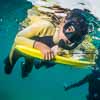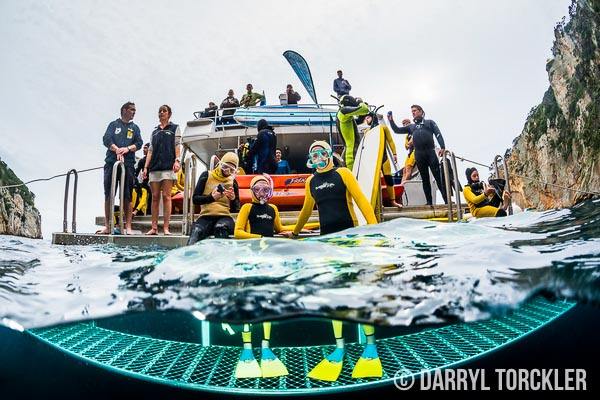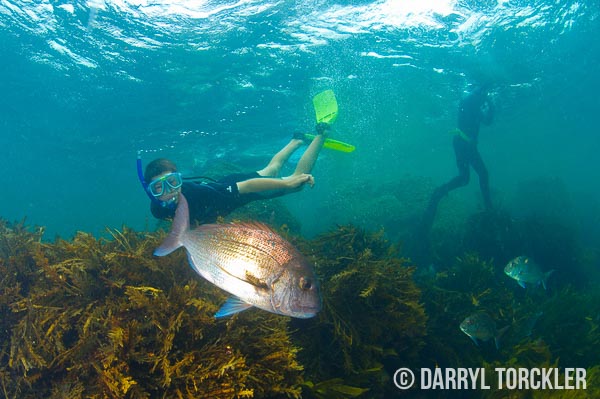 (EMR) is a national programme of experiential learning about marine conservation. Our EMR - Te Kura Moana programme empowers schools and communities by providing hands-on experience in the ocean.
(EMR) is a national programme of experiential learning about marine conservation. Our EMR - Te Kura Moana programme empowers schools and communities by providing hands-on experience in the ocean.
Since 2001, EMR has taken 73,180 people into NZ’s marine reserves/rahui and over 27,291 people have been engaged in EMR organised marine conservation events. A total of 147,905 people have snorkelled with EMR. The total number of Kiwis engaged in EMR has now reached 207,494 .

Delivered by an EMR coordinator the programme is designed to set the kids abuzz before progressing to developing their snorkelling skills in a pool then heading to the real marine environment. We increase awareness and encourage action and support for marine conservation and kaitiakitanga.
The EMR brand is unique; we have an active focus on community engagement and marine conservation. We are committed to delivering safe snorkel excursions and we are adventure activity safety audit certified (AAO 534). The national expansion of EMR is based on a non-profit franchise concept.
Our full EMR programme involves a succession of experiences promoting kaitiakitanga from investigating marine biodiversity and the local marine environment before venturing to a marine protected area. After this experience, students are able to compare unprotected and protected areas and are encouraged to put their knowledge into action within the community!
We create awesome real life marine experiences, not just for kids but adults too. Engagement of adults as supervisors is a natural by-product and in-water experiences and activities often prove as powerful to the adults involved as the students, these shape caring attitudes and emotional connections. We have a range of funded programmes and ‘casual’ user pays opportunities, these are our Te Kura Moana snorkel experiences. EMR reinforces simple concepts such as the uniqueness of our marine biodiversity and provides an active focus on conservation of these environments through education and action.
Kaitiaki Action
Our EMR kaitiaki action projects create long term impacts for the protection of our marine environment for future generations. Over the years hundreds of action projects have resulted in positive changes for Aotearoa’s marine environment, including marine monitoring, dune restoration, riparian restoration, public awareness raising for marine conservation and marine pest detection!
Background
The name Experiencing Marine Reserves is associated with the kaupapa of ‘no-take’ and implies the association with not collecting/non disturbance, just a looking and learning focus. All school and group field trips are no-take (no matter where we are!), unless cultural or scientific aspects to the kaupapa on the day.
A ‘no-take’ kaupapa also creates a safer snorkel experience, adopting the concept of manaakitanga and promoting the water safety code. Over the years snorkelling in marine reserve’s has provided the most inspiration (I saw a massive snapper!). We see marine reserves as rich educational tools and often refer to them as ‘wet libraries’. Marine Reserves provide sanctuary for fish and other marine life, to live and breed. They provide a natural benchmark against which to measure the state of other areas, where our kids can actually see and enjoy the natural variety, sizes and abundance of fish, seaweeds and invertebrates in a fully functioning ecosystem.
We also snorkel at a variety of other marine habitats and marine protected areas, such as rahui, mataitai and Taipure.
EMR supports all forms of marine protection that enhance marine biodiversity for future generations.
Our reach is not limited to school programmes, throughout the summer we offer a range of community engagement events such as community guided snorkel days, throughout the motu. Our programmes and events provide a constant groundswell of community participation. We developed rangatahi training events to fill a void in volunteer snorkel guides for the youth age group. In Northland we offer taitamariki/rangatahi, who have an affinity for the moana to engage in our ‘Marine Mahi for Rangatahi’ kaupapa through mentorship and volunteer development, focusing on marine pest detection, marine biodiversity monitoring, snorkel guiding, marine reserve/ rāhui surveillance, marine education and supporting a career pathway. All have become water safety and conservation influencers.
Our offer
EMR coordinators offer guidance, direction and coordination of classroom exercises and field trips to the ocean. We also provide snorkel equipment, instruction, resources and snorkel risk management. For many students, it is their first time using snorkel gear. Express your interest here.
Aim
To engage as many people as possible in meaningful experiences in the marine environment
Objectives
- To provide safe and supervised snorkelling that enables participants to experience the marine environment first -hand.
Build water safety and confidence in the real environment - Inspire positive attitudes and actions for protecting our marine environment.
- Empower and support local aspirations for marine conservation and kaitiakitanga
- Support and facilitate projects that result in awareness and/or action to address marine issues.
- Rangatahi engagement at our marine conservation events.
- Grow marine mahi for rangatahi project
Outcomes
- In-water experiences become lifelong memories
- Inspiration for restoration of marine ecosystems
- Community participants go on to become valued volunteer snorkel guides
- Restoration of marine ecosystems by supporting iwi/hapu and communities to implement marine protection
- Provide community engagement events that assist with management of marine protected areas
- Bring together western science and mātauranga Māori concepts for delivery.
- Deliver snorkel experiences in ‘Reo Rua’
- Create community pride and ownership of existing marine reserves and new marine protected areas
- Support and grow rangatahi/taitamariki/youth mentorship,, building on training and cadetship opportunities
- Communicate science and understanding about marine conservation into the wider communities where EMR operates
- Increase support for new or proposed marine protected areas
- Motivate action projects that enhance the marine environment
- Inspire community led action
Core values in all areas of our operation
- Mana whenua/moana are communicated with from the outset in each rohe we work in. Our approach is one of open consultation, authenticity, co-creation and collaboration.
- Ensure our programme delivery follows tikanga and can be delivered authentically and incorporate Mātauranga Māori and Te Ao Māori.
- EMR Kaupapa - Look and learn at all times (except cultural or scientific events outside of marine protected areas)
- Foster local community involvement whenever possible
- Teaching and activities retain a NZ focus
- All snorkelling in accordance with EMR SOP, MTSCT SMP and adventure activity safety audit standard (certification AAO 534).
Where and when does EMR operate?
The EMR programme has been operational in Northland since 2002 and available to other parts of New Zealand since 2004. You'll find our find regional contact details here. Due to the seasonal nature of the programme, it is offered in terms 1 and 4 when the weather is warmer and more suitable for snorkelling. Email us at
Structure
The Mountains to Sea Conservation Trust (MTSCT)) is a charitable entity based in Northland and was formed in 2002. We have an active focus on the restoration of marine ecosystems and together with the Whitebait Connection (WBC), the restoration of catchments, from the Mountains to the Sea. Whitebait Connection
Imagine snorkelling amongst a dense kelp forest, surrounded by dozens of fascinating new life forms. A frenzy is created on top of the water. Someone has spotted a crayfish, and everyone is taking turns to dive under to get a glimpse of a cray crouching under a ledge. Students come up gasping for breath, but feel reassured by their adult buddy and bright yellow body board for time out. Some large snapper cruise past to see what the fuss is about. Gurgling sounds come from a snorkel, while an eagle ray rests on the sand below. The kids are easy to spot in their bright yellow & black wetsuits. The parents come in buzzing, and the kids madly tell their mates about how big the snapper they swam with was and how many different fish they saw. This is normal conversation during EMR programme delivery.

